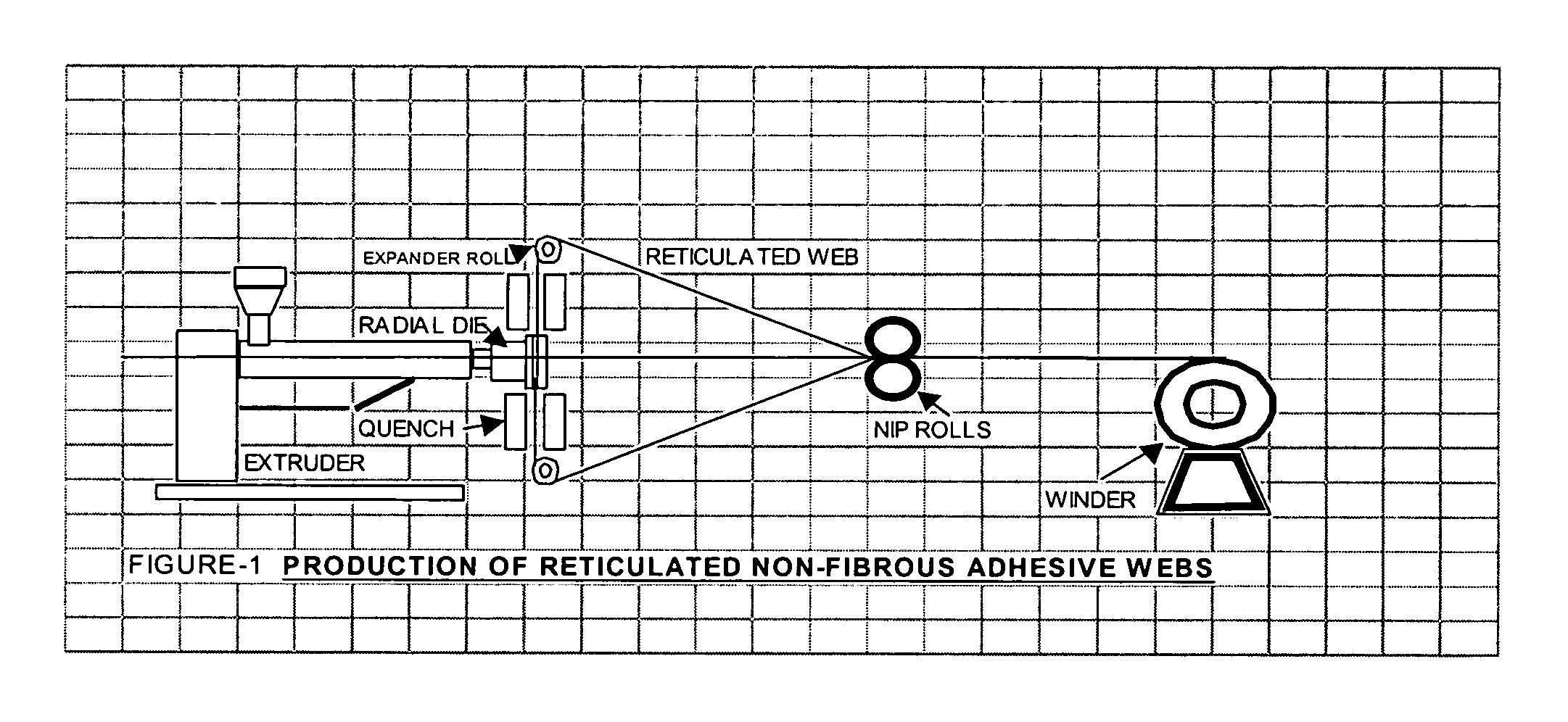Non-fibrous adhesive matrix and laminate formed therefrom
- Summary
- Abstract
- Description
- Claims
- Application Information
AI Technical Summary
Benefits of technology
Problems solved by technology
Method used
Image
Examples
example 1
Web Production with Poly (Ether-Amide) Block Polymer
[0032]
Raw Material:Pebax ® block polymer supplied by the ElfAtochem Company - 90 partsProcessing Aid:10 partsBlowing agent:Azodicarbonamide - 1.0%, by weight basedon the weight of polymer and processing aidMixing:Raw material and blowing agent were dry-blended ina drum-mixer for 25 minutes.Extrusion System:Shown in FIG. 1Extruder:1¼-inch standard single-screw extruderDie Type:Radial, having an extrusion slot diameter of 8.0 inchesQuench:Radial, to accommodate the dieExpander Roll:Diameter of 26.9 inchesNip Roll:Typical pneumatic nip rollWinder:Standard textile winder
Details of Web Production
[0033]The freshly mixed blend of raw material was fed into the hopper of the extruder, which was set at a temperature profile to melt the polymer to a melt temperature of about 350° F. A foamed extrudate was extruded from the radial die with simultaneous quenching to form a stereoreticulated extrudate that is further developed while expanding ov...
example 2
Web Production from Thermoplastic Polyester Elastomer
[0036]
Extrusion System:illustrated in FIG. 1.Raw Material:Hytrel ® polymer supplied by the DupontCompany - 90 partsProcessing Aid:10 partsBlowing agent:Azodicarbonamide - 1.0%, by weight, based onthe weight of polymer and processing aidMixing:Raw material and blowing agent were dry-blended in a drum-mixer for 25 minutes.Extruder:1.25-inch standard single-screw extruderDie Type:Radial Extrusion Slot die having an 8.0-inchdiameterQuench:Radial, to accommodate the dieExpander Roll:Diameter, 26.0 inchesNip Roll:Typical pneumatic nip rollWinder:Typical textile winder
Details of Web Production
[0037]The freshly mixed blend of raw material was fed into the hopper of the extruder that was set at a temperature profile designed to melt the polymer to a melt temperature of about 305° F. A foamed extrudate was extruded from the radial die with simultaneous quenching to form a reticulated extrudate that was further developed while expanding over...
example 3
Contour Bonding Shaped Articles Using Elastomeric Polyester Copolymer Stereoreticulated Non-Fibrous Matrix as the Adhesive Web
[0040]A moldable, thermoformable polyurethane foam and a woven polyester (polyethylene terephthalate) / cotton fabric were bonded into a shaped article using as the non-woven adhesive matrix a polyester elastomer copolymer in the form of a stereo reticulated non-fibrous matrix produced by the process of Example 2, as the adhesive. The processes of bonding and forming the shaped article occurred simultaneously. The device used for this process was a heated molding contour press with mating top and bottom forming molds, as shown in FIG. 3 below. The initial substrate dimensions were as follows:
[0041]
Moldable FoamArea Dimension (inches):20 × 24Thickness (inches):2 Woven FabricArea Dimension (inches):20 × 24Thickness (inches):0.008-0.012Adhesive Non-fibrous MatrixArea Dimension (inches):20 × 24Weight per unit area (ounce / yard2):1.00
[0042]The three substrates were ...
PUM
| Property | Measurement | Unit |
|---|---|---|
| Fraction | aaaaa | aaaaa |
| Length | aaaaa | aaaaa |
| Diameter | aaaaa | aaaaa |
Abstract
Description
Claims
Application Information
 Login to View More
Login to View More - R&D
- Intellectual Property
- Life Sciences
- Materials
- Tech Scout
- Unparalleled Data Quality
- Higher Quality Content
- 60% Fewer Hallucinations
Browse by: Latest US Patents, China's latest patents, Technical Efficacy Thesaurus, Application Domain, Technology Topic, Popular Technical Reports.
© 2025 PatSnap. All rights reserved.Legal|Privacy policy|Modern Slavery Act Transparency Statement|Sitemap|About US| Contact US: help@patsnap.com



